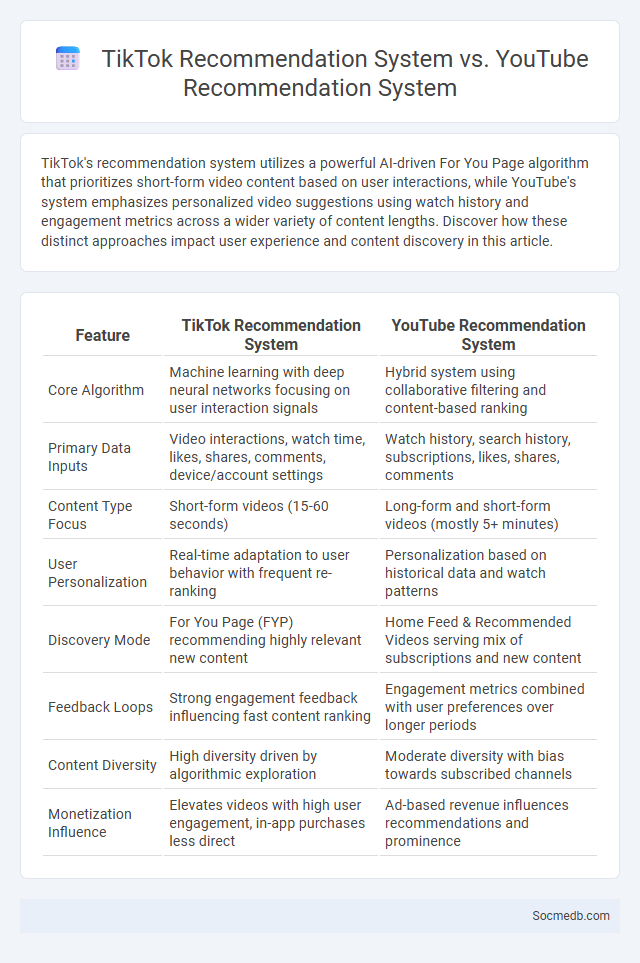
Photo illustration: TikTok Recommendation System vs YouTube Recommendation System
TikTok's recommendation system utilizes a powerful AI-driven For You Page algorithm that prioritizes short-form video content based on user interactions, while YouTube's system emphasizes personalized video suggestions using watch history and engagement metrics across a wider variety of content lengths. Discover how these distinct approaches impact user experience and content discovery in this article.
Table of Comparison
| Feature | TikTok Recommendation System | YouTube Recommendation System |
|---|---|---|
| Core Algorithm | Machine learning with deep neural networks focusing on user interaction signals | Hybrid system using collaborative filtering and content-based ranking |
| Primary Data Inputs | Video interactions, watch time, likes, shares, comments, device/account settings | Watch history, search history, subscriptions, likes, shares, comments |
| Content Type Focus | Short-form videos (15-60 seconds) | Long-form and short-form videos (mostly 5+ minutes) |
| User Personalization | Real-time adaptation to user behavior with frequent re-ranking | Personalization based on historical data and watch patterns |
| Discovery Mode | For You Page (FYP) recommending highly relevant new content | Home Feed & Recommended Videos serving mix of subscriptions and new content |
| Feedback Loops | Strong engagement feedback influencing fast content ranking | Engagement metrics combined with user preferences over longer periods |
| Content Diversity | High diversity driven by algorithmic exploration | Moderate diversity with bias towards subscribed channels |
| Monetization Influence | Elevates videos with high user engagement, in-app purchases less direct | Ad-based revenue influences recommendations and prominence |
Overview of TikTok and YouTube Recommendation Systems
TikTok's recommendation system leverages advanced machine learning algorithms to analyze user interactions, video information, and device data, delivering highly personalized content that boosts user engagement and retention. YouTube's recommendation engine combines collaborative filtering with deep neural networks, focusing on watch history, search queries, and user feedback to suggest videos tailored to individual preferences. Understanding these platforms' recommendation mechanisms can enhance your content strategy and increase visibility within their vast user bases.
How TikTok’s Algorithm Personalizes Content
TikTok's algorithm personalizes content by analyzing user interactions such as likes, shares, comments, and watch time to create a tailored For You page. It leverages machine learning models to predict user preferences based on past behavior, ensuring relevant video recommendations. This dynamic personalization enhances user engagement by continuously refining content suggestions in real-time.
The Inner Workings of YouTube’s Recommendation Engine
YouTube's recommendation engine leverages deep learning algorithms and user behavior data to deliver personalized video suggestions, analyzing watch history, search queries, and engagement metrics. The system employs collaborative filtering and content-based filtering techniques to predict content relevance, optimizing viewer retention and session duration. Machine learning models continuously update to refine recommendations, balancing user interests with platform-wide content diversity and advertiser priorities.
Key Differences Between TikTok and YouTube Algorithms
TikTok's algorithm emphasizes short-form video content with rapid engagement signals, using watch time, likes, shares, and comments to quickly surface trending videos to your For You page. YouTube's algorithm prioritizes longer-form content, balancing watch time, viewer retention, and personalized recommendations based on your search history and subscriptions. Understanding these key differences helps you optimize content strategies tailored to each platform's unique user behavior and discovery methods.
Data Collection and User Profiling Techniques
Social media platforms employ advanced data collection methods such as tracking user interactions, location data, and content engagement to build detailed user profiles. Machine learning algorithms analyze behavioral patterns, preferences, and demographics to personalize content and advertisements effectively. These user profiling techniques enhance targeted marketing strategies and improve user experience through customized recommendations.
The Role of Engagement Metrics in Content Ranking
Engagement metrics such as likes, comments, shares, and time spent on content heavily influence social media content ranking algorithms by signaling relevance and user interest. Platforms analyze your interaction patterns to prioritize showing you content that generates high engagement, ensuring personalized and engaging experiences. Optimizing your content to increase authentic engagement is crucial for improving its visibility and reach.
Algorithmic Bias: Definition and Real-World Impact
Algorithmic bias in social media refers to the systematic favoritism or discrimination embedded within the algorithms that curate content, influenced by data inputs and design choices. This bias can lead to unequal visibility, reinforcing stereotypes and marginalizing certain groups, which impacts user experience and shapes public opinion. Real-world consequences include exacerbated social divides, misinformation spread, and reduced diversity in online discourse.
Sources of Bias in TikTok and YouTube Recommendations
TikTok and YouTube recommendation algorithms prioritize user engagement metrics, which can amplify content bias by promoting videos that align with viewers' existing preferences. These platforms often rely on data signals such as watch time, likes, and shares, leading to echo chambers and reinforcing popular but potentially skewed narratives. User demographics, regional trends, and advertiser influence also contribute to biased content exposure, shaping user experience and perception.
Strategies to Mitigate Algorithmic Bias
Strategies to mitigate algorithmic bias in social media include implementing diverse training data sets to ensure representation across different demographics, reducing skewed or unfair content recommendations. Regular audits and transparency reports help identify and address biases, enhancing trust and accountability. Incorporating feedback mechanisms from users enables continual refinement of algorithms to better serve equitable content distribution.
Future Directions for Fairer Recommendation Systems
Future directions for fairer recommendation systems in social media emphasize the integration of advanced bias mitigation algorithms and diverse data representation to ensure equitable content exposure across different user demographics. Leveraging explainable AI techniques can enhance transparency, allowing Your social media experience to be more accountable and personalized without sacrificing fairness. Ongoing research prioritizes adaptive learning models that continuously update recommendations based on evolving ethical standards and real-time user feedback.
 socmedb.com
socmedb.com